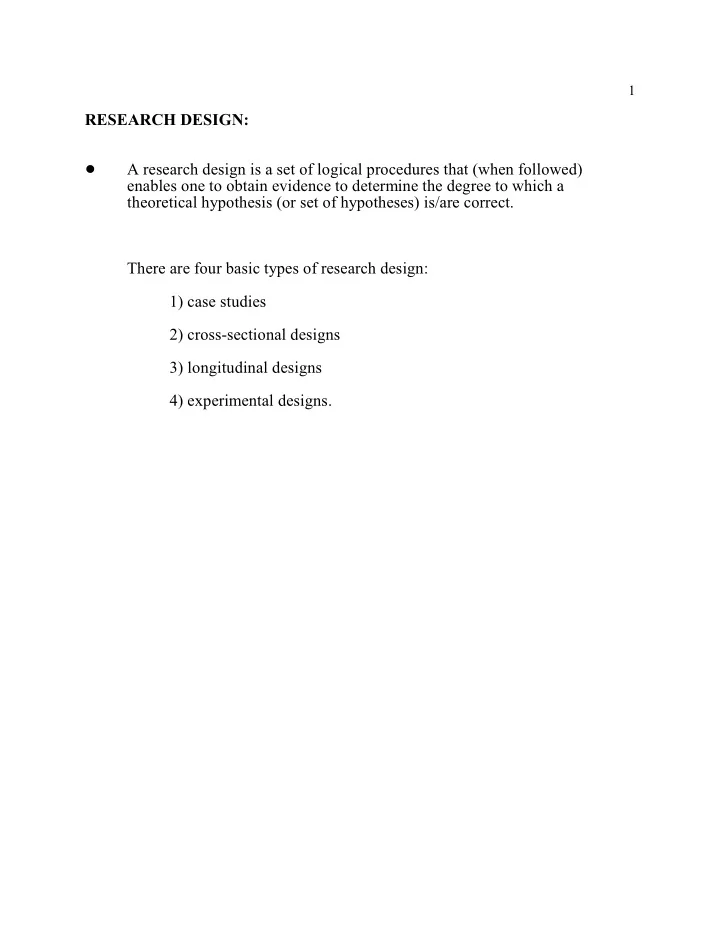

1 RESEARCH DESIGN: A research design is a set of logical procedures that (when followed) ! enables one to obtain evidence to determine the degree to which a theoretical hypothesis (or set of hypotheses) is/are correct. There are four basic types of research design: 1) case studies 2) cross-sectional designs 3) longitudinal designs 4) experimental designs.
2 CASE STUDIES Some Definitions According to Babbie(2001:G1) a case study is “[t]he in-depth examination of the single instance of some social phenomenon, such as a village, a family, or a juvenile gang.” According to Yin (1994:13): A case study is an empirical inquiry that: • investigates a contemporary phenomenon within its real-life context, especially when the boundaries between phenomenon and context are not clearly evident. The case study inquiry: • copes with the technically distinctive situation in which there will be many more variables of interest than data points. • (as a consequence it) relies on multiple sources of evidence, with data needing to converge in a triangulating fashion • (and thus) it benefits from the prior development of theoretical propositions to guide data collection and analysis.
3 Case studies are most useful for descriptive/exploratory research. E.g., field ! research. From your field notes (or other type of data) you can examine the logic of change over time and compare the results of your study with others described in the literature. Validity is a strength (because of the naturalness of the research setting). Generalizations to other groups is difficult.
4 * SHOW OVERHEAD ILLUSTRATING CROSS SECTIONAL AND LONGITUDINAL DESIGNS *
5 CROSS SECTIONAL DESIGN Cross sectional design is based on observations made at one point in time. ! E.g., survey research. In particular, when the data collection strategy is broader in scope (involves considerably more than one case or a small group) and involves systematic data collection we use the term cross sectional instead of case study to describe it. With cross sectional designs it is difficult to make inferences about processes that occur over time ... and hence cause and effect. Usually such studies are done for exploratory and descriptive research, but sometimes also for explanatory studies. The generalizability of such studies is good -- because they are representative of given populations (e.g., when data has been collected systematically, and some probability sampling technique has been employed).
6 LONGITUDINAL DESIGNS These are studies in which multiple observations are made over time. E.g., ! survey research. There are three basic types of longitudinal designs: trend studies , cohort studies , and panel studies . Trend Studies Trend studies examine changes within some general population over time. ! Cohort Studies Cohort studies examine more specific subpopulations (cohorts) as they ! change over time. Panel Studies Panel studies are similar to trend and cohort studies except that the same set ! of people is studied each time.
7 Panel studies give a more complete picture of how individuals change over time. Cohort and trend studies uncover only net changes. Example public opinion studies. Longitudinal studies have an obvious advantage over cross-sectional ones in providing information describing processes over time. But often this advantage comes at heavy cost in both time and money ... especially in large scale surveys. Panel studies are the best type of longitudinal design to study cause and effect. (Explanatory studies.)
8 * SHOW OVERHEAD ILLUSTRATING EXPERIMENTAL DESIGN *
9 CLASSICAL EXPERIMENTAL DESIGN The classical experimental design consists of two groups (a control and ! experimental group) based on random assignment. Some examples include: social psychology experiments, and quasi- experiments. You start with two groups of people (assumed to be the same) and measure them on the dependent variable . It is assumed that there will be the same level of variation within each group. You then do something to one of the groups (e.g., introduce a stimulus to ! the experimental group ) but not to the other ( control group ). Then you measure the dependent variable again.
10 This procedure provides a test of the hypothesis that there's more change in the experimental group than in the control group. Control is a strength of this design. (This is sometimes referred to as internal validity). In sociology it's difficult to implement a true classical experimental design. Hence longitudinal research is often undertaken to compensate. * The goal of other designs is to approximate the classical experimental design.
Recommend
More recommend